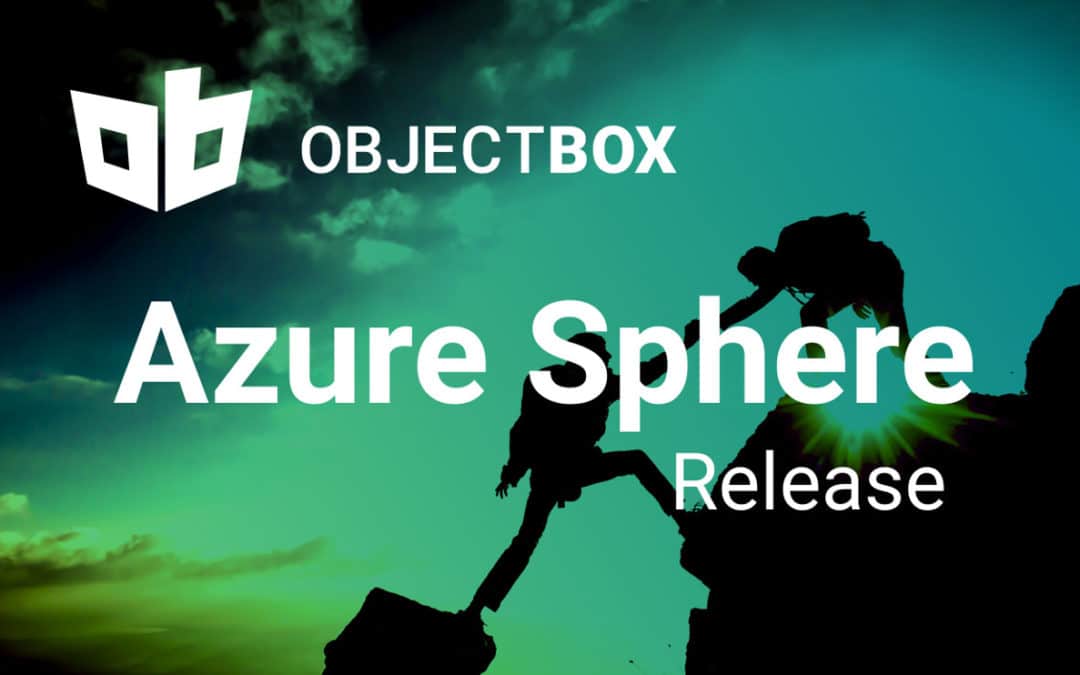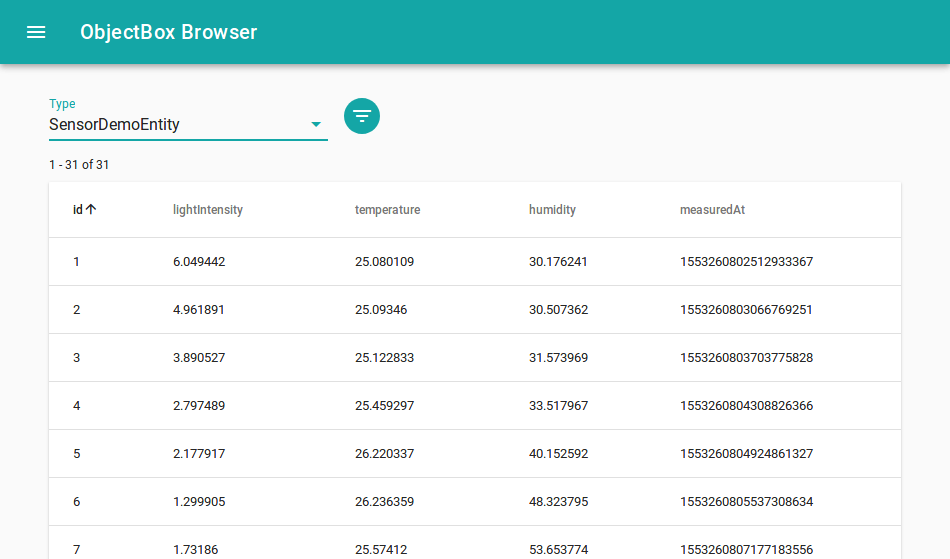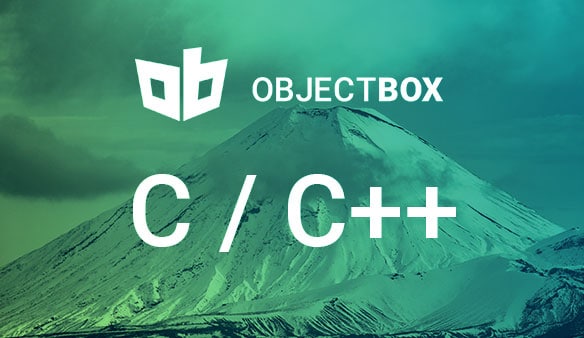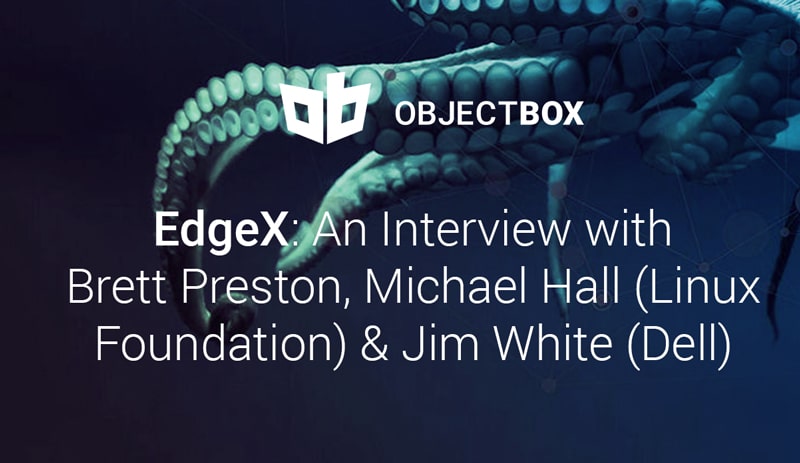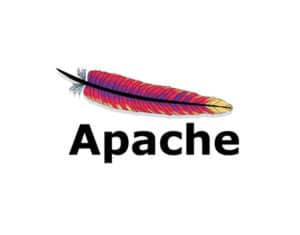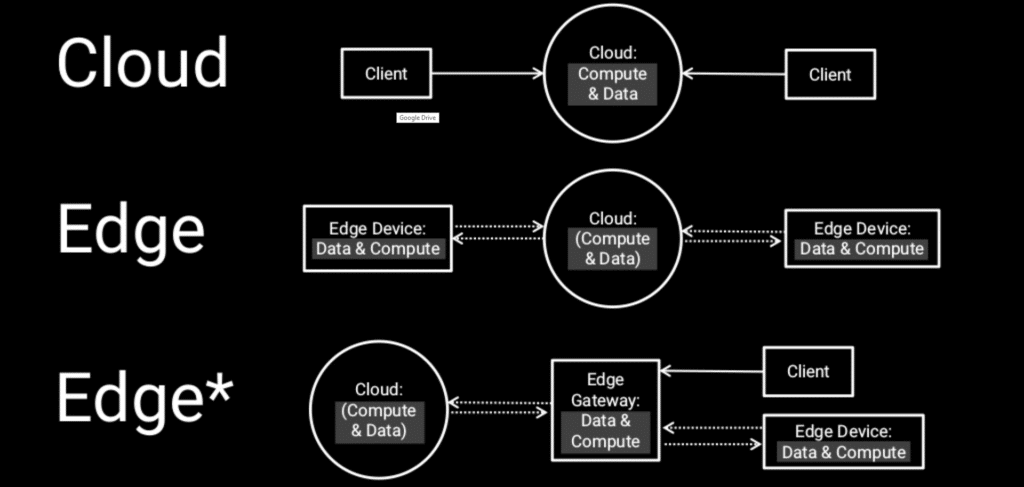
How to benchmark database performance – and ObjectBox
Benchmarking the performance of databases is a science in and of itself and it’s hard to get reliable and comparable results. Therefore, we decided to note down some standard patterns and pitfalls when doing database benchmarks we learned about over the years. We are including specific notes and things to consider when benchmarking ObjectBox.
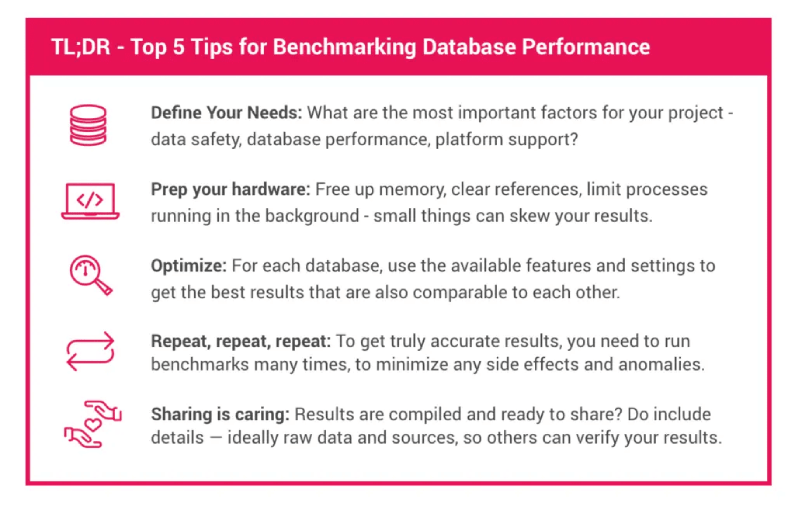
Designing a benchmarking test
Phrase your research question
When you want to benchmark databases, you will usually have a specific use case in mind and want to answer questions regarding that case. Therefore, before writing your first line of code, have a look at what it is you want to benchmark, why, and what statement you want to be able to make at the end. Just writing down a simple question like “Is X faster than Y doing A?” can help you verify that the finished benchmark actually measures what you want it to.
Start documenting
Whatever you do, document each step diligently. Benchmarks that are not properly documented are challenging to reproduce, and thus of limited worth. So, the mantra in benchmarking really is: Document, document, document. That way it is also easier to go back later and make adjustments if needed.
Select the sample
If you have a clear use case and goal in mind, this probably determines the type of databases you are going to consider for your benchmark. Generally speaking, benchmarks should compare databases of similar type and not mix approaches that are too different. A database might be designed to run on a cluster of servers and not, like ObjectBox, on a constrained device (e.g. a smartphone, Raspberry Pi or IoT device). Or data may be stored as documents (e.g. NoSQL) and not in a relational table-like structure (e.g. SQL); or on disk and not in-memory. Consistency guarantees can also make a difference (ACID-compliance vs. not transactionally safe). Document why you chose these databases for comparison.
Become an expert
Once you have decided on what databases and features to compare, familiarize yourself with the APIs of the products, e.g. by reading the documentation or looking at code examples. Making wrong assumptions about how a feature works can skew your results and make a product appear much faster or slower than it actually is. If the code is open source, it can also help to dive into the code to see how things actually work. For example: an insert function runs asynchronously so the function call returns immediately, but the actual insert still executes in the background. To correctly measure the actual time it takes to complete the insert, you need to do some additional work.
Things to watch out for when coding benchmarks

Let’s move on to some specific coding tips. A benchmark is only as good as its time measurement. Check what APIs your test platform offers to get the time; they might be affected by how and from which thread they are called. Make sure, you find an accurate way to measure the time that does not skew up your results. For example, on Android there are numerous possibilities beyond using currentTimeMillis().
If a measured code block executes so fast it is near the available precision of your clock (e.g. time is in milliseconds, but code takes microseconds), consider running it multiple times and measure the total time of all runs.
Next, before starting each measurement, make sure to free up memory and clear references no longer in use by the previous measurement or setup code. If the environment your benchmark is written for uses a garbage collector, check if it can be triggered manually to free memory (e.g. System.gc() in Java). Otherwise each consecutive measurement might be skewed due to less and less memory being available or a garbage collector halting execution to free memory. In your benchmarking results, you should look out for strange results like a continual decrease in performance from run to run.
Furthermore, take into account that some runtime environments, for example the Java Virtual Machine, do just-in-time compilation. This can cause a delay the first time code is executed, but provide better performance on subsequent executions. The effect of this on the final result can however be minimized by proper testing procedure, e.g. by running a code block multiple times instead of once and measuring the total execution time.
Then something obvious, but easily overlooked, is to ensure that between the start and end of a measurement only the functionality that you actually want to compare is executed. So avoid or turn off logging (a seemingly innocent string concatenation can skew results) and construct test data outside of a measured code block.
To be absolutely sure that your code is doing what you intended it to, use a profiler to inspect resource usage during a trial run. IDEs like Android Studio and Xcode come with an embedded profiler, and there are also several standalone profilers to choose from.
Optimizing benchmarks for meaningful results – with ObjectBox examples
Before benchmarking the chosen databases, make sure you understand their differences and default settings to adjust all settings to be comparable. In the following section, we will go through the most important differences and settings you need to look out for based on ObjectBox as an example.
Transactions, Durability, Consistency, ACID – how to make your benchmarks comparable
First, be aware of the impact the use of transactions or lack thereof can have. For databases, committing a transaction is an expensive operation as it requires waiting until the disk has safely stored the data. If possible, group multiple operations into a single transaction. For example, in the ObjectBox code snippet below, there is a notable speed-up when wrapping multiple box operations into a transaction block.
|
1 2 3 4 5 6 7 8 9 10 |
boxStore.runInTx(() -> { // Would be slower if run outside of a transaction. for (User user : allUsers) { if (modify(user)) { box.put(user); } else { box.remove(user); } } }); |
Speaking of transactions, also check if using bulk operations is possible. These also use transactions to speed up execution. E.g. instead of performing a put on each entity in a list, put the whole list.
|
1 2 3 4 5 6 7 8 9 10 11 |
// Total cost: allUsers.size transactions. for (User user : allUsers) { modify(user); box.put(user); // Implicit transaction } // Total cost: 1 transaction. for (User user : allUsers) { modify(user); } box.put(allUsers); // Implicit transaction. |
The ObjectBox transactions docs provide more details and are available for Java, Swift or Go – though the basic principle is the same across languages.
Second, and closely related to transactions, are durability guarantees when writing data. This is about the “D” in the popular ACID acronym (Atomic, Consistent, Isolated and Durable). ObjectBox transactions and standard (non-async) operations are fully ACID-compliant.
Thus, pay close attention to what durability modes other tested databases guarantee, or respectively, which durability mode you want to measure. Most NoSQL databases don’t give hard durability guarantees. Some provide an extra command or special mode to enforce durability. Therefore, if your use case needs to ensure data is actually stored safely after a write operation, you would need to enable this durability for other databases when comparing to ObjectBox.
On the other hand, if you are interested in scenarios that emphasize performance over durability, you should look into the OjectBox async APIs. Those don’t come with durability guarantees unless you define “checkpoints” in your code to wait for async operations.
Indexing – how to make your database queries efficient
Third, when measuring query operations, see if you can use indexes, another typical database optimization. If the database has an index on a property that is used in a query condition, it can find matches much faster.
|
1 2 3 4 5 6 7 |
// Adding an index in a fictitious User class: @Index String name; // Makes this query faster: userBox.query() .equal(User_.name, "Jane") .build().find(); |
An index makes queries “scalable” – the more objects are stored, the more an index makes sense. Without an index, a database has to do a “full scan” over all potential results.
Number of objects and the disk bottleneck – how to measure the database and not the disk
And lastly, keep an eye on the number of objects you operate on. For example, if you put a single object, something like 99.99% percent will be spent on disk I/O. Thus, if you test this on several databases, the chance of getting about the same results on all databases is quite high. The limiting factor is always the disk. So if you want to measure the efficiency of converting objects into their persisted counterparts instead, you should look at much higher object counts to factor the disk out of the equation. Depending on the disk and device speed, a bulk “put” of 10K, 100K or 1 million objects will make more sense to measure in this context.
Multi threaded tests – how to set writers and readers
ObjectBox is build upon a multiversion concurrency control foundation, and thus is ready for multi threaded access. Each thread will have a consistent transactional view of the data. ObjectBox differentiates between “readers” (a thread currently in a read transaction) and “writers” (a thread currently in a write transaction). Readers never block; no matter what goes on in other threads. However, a writer will block other writers when using standard transactions. Writers are sequential; only a single writer can be run at any time. Thus, if your load is write-heavy in multiple threads, you may want to look at the asynchronous APIs of ObjectBox. These handle write operations very efficiently; no matter how many threads are involved.
Extending the database size limit – size matters
By default, ObjectBox limits the database size to 1 GB to avoid filling up the disk by accident (e.g. your code has a bug in a data insertion loop). So if you use large data sets to benchmark, we recommended increasing the maximum database size when building the box store.
|
1 2 3 |
MyObjectBox.builder() .maxSizeInKByte(10 * 1024 * 1024 /* 10 GB */) .build() |
Preparing the benchmarks: devices and platforms

Once your benchmark code is ready, it’s time to set up the test device(s). The first step is to ensure other apps or processes are not doing (too much) work while your measurements run. Ideally, you would use a clean device with no apps installed or services configured. This is especially true for mobile devices: once you connect them and they start charging, the operating system might wake numerous apps to perform background work or network updates. You can somewhat avoid this by switching on airplane mode. And to be safe, wait a few seconds after connecting the device.
Also ensure, this is again important for mobile devices, that your device does not enter a low power mode which reduces performance. For example on Android, keeping the screen on typically prevents that. When running on a laptop, check whether the power supply is plugged in and which power mode your operating system is set to. You may explicitly want to test in a certain power state or with the default behavior.
And just to mention it, make sure to turn off any profiling or monitoring tools that you used during building your benchmark. They can significantly skew your results.
When running on multiple devices, pay attention to the differences in hardware, like available memory and processor model, but also in software, like the operating system version. Different hardware and software might have different optimizations that can skew your results. Again, do not forget to document your device and software setup, so results can be properly interpreted and reproduced.
Running the database benchmark and collecting results
When it is time to run the benchmark it’s good to run it not once, not twice, but many times. This minimizes the impact of the various side effects we discussed above. Output the results of each run into a comma separated (CSV) or tabulator separated (TSV) format, that can easily be imported in a spreadsheet application for analysis. You can look at how the ObjectBox benchmark does it.
Once you have collected some data, verify its quality. You might have already spotted outliers while perusing the results. Alternatively, calculate the average of all measurements and see if it deviates a lot from their median value. If you are familiar with it, look for a high variance value instead. Too many outliers or a high variance might hint at side effects of your benchmark code or device setup you have not considered. Better double check to be sure.
Also coming soon ObjectBox time series which will provide users an intuitive dashboard to see patterns behind the data. It will further help users to track thousands of data points/second in real-time.
How to publish meaningful database performance benchmarks
The final step is to share your results with the world (or just your team). Make sure it’s clear what exactly you have measured and how you have arrived at those results. So include which device and software was used, how they were configured, what you did before running the benchmark and how the benchmark was run.
If possible, share the generated raw data so others can verify that your calculations, and remember to lead to the published results. Even better, publish the source code as well, so others can run it on other devices or help you spot and fix issues.
Last not least: Be careful to draw conclusions. Rather let the data speak for itself. Respond to questions and feedback. Be honest, if you learn your benchmarks may be skewed and update them. In the end, everyone wins by getting more meaningful results.
Your content goes here. Edit or remove this text inline or in the module Content settings. You can also style every aspect of this content in the module Design settings and even apply custom CSS to this text in the module Advanced settings.






